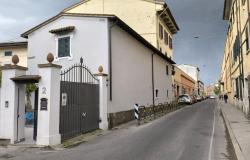BOLZANO. «Disability forced me to make many sacrifices and change my daily life, but it gave me a better life back. Today I feel proud of what I have become and how I reacted after the accident. And I owe a lot of it to table tennis.” Ada Cappelletti, 26 year old from Bolzanois miraculously alive after a van hit her in November 2019 while she was crossing Via Volta on the pedestrian crossing.
For three weeks he fought in the intensive care unit of San Maurizio and in record time he got his life back. «Rehabilitation, treatment and physiotherapy were combined with a course of therapy – he continues – The hospital offered me various sporting activities and among these was table tennis. I had never tried it before: it was love at first sight.” Within a year and a half she qualified for the Italian championships and now she dreams of the Paralympics.
Together with Cappelletti, in the meeting in the editorial office with the journalists from Alto Adige, there was also Samuel De Chiara, from Merano, 32 years oldin turn affiliated with the “ASV TT Sudtirol” company in via Maso della Pieve: «I was born prematurely, at the twenty-sixth week – says De Chiara – I had a cerebral hemorrhage and I have always suffered from hemiparesis (a partial loss of motor function of one half of the body, ed.)”.
De Chiara, a champion of life before sport, came across a passion for table tennis by chance: «I started at 13 during a campsite where there was only a table and two rackets. As soon as I returned home I contacted a company and my career started from that day. In 2013 I won a place in the national team, while in 2017 I became European vice champion. I participated in the World Championships and reached eighteenth position in the international ranking. The Paralympics? I miss them, but it’s not too late.”
Table tennis is a long-lived sport, especially when talking about Paralympic athletes. De Chiara assures that you can play at high levels even “over the age of 40” because it is a “tactical game rather than a game of speed”. The true definition, which she faithfully reports to us, comes from her first teacher: «It’s like running 100 meters while playing a game of chess. A combination of physical and psychological fatigue, each ball is different and therefore you have to adapt your game to the opponent. There is great strategy and thought behind every shot.”
Ada Cappelletti, on the other hand, cannot do without it because «it is a very schematic sport, which seems made especially for hyper-organized people like me». What differentiates the two South Tyroleans is the type of disability. The use of the wheelchair, as in Ada’s case, allows you to move forwards and backwards, not to the sides: it is the trunk that does most of the work and allows the athlete to move left and right. While if the athlete is quadriplegic the racket is tied to the arm. To ensure balance within the individual matches, participants are divided into classes (from 1 to 10) based on the level of physical disability.
The gap with the able-bodied
When we talk about disabilities in sport, the distance between Olympic and Paralympic athletes is often highlighted. As if they were two separate worlds, which never meet. «But in the case of table tennis the real gap to fill is the one with other sports. Ours isn’t seen on TV, it struggles with sponsors and has a relatively low number of members, around 13 thousand in the whole of Italy”, underlines De Chiara, going to the root of the problem, “The kids approach us through the playground , to what everyone calls “ping pong”. This transition from amateur to competitive is very complicated because most people get bored after a couple of lessons. Kids today don’t apply themselves as much as they used to. And I think it’s due to too many distractions that our society offers.”
If De Chiara’s next objective has the shape of five circles, Ada Cappelletti’s looks to the next one. To those who, like her, will face an accident: «I would like to work in spinal units to give advice to people who have suffered a trauma – concludes the Bolzanina – I have taken courses and I am waiting for them to contact me to start internships. I don’t want to replace the doctor, but I can represent a reference for those who don’t know how to approach the world in a wheelchair. If it were conceived as a job, as in other parts of the world, it would be a gain for everyone.”






